Bringing Something New into the Classroom
my experience bringing literary theory into our classroom this year (so far!)
“Mr. Luther, can I use a gender lens to explain the significance of this moment?”
Just yesterday, a student raised their hand to ask if they could apply their learning from our previous unit centered on literary theory in their group analysis of a moment within our current text: Their Eyes Were Watching God by Zora Neale Hurston.
And, of course, I nodded enthusiastically.
Along the same lines, the lesson before—in reading the conclusion of Chapter 7 when Joe strikes Janie after she has ridiculed his “manhood” in public—we had ended class once again circling back to a gender lens in our commentary: of how a version of masculinity defined by, in Zora Neale Hurston’s words, the “illusion of irresistible maleness that all men cherish” is not only toxically flawed and fragile but also dangerous, with the consequences tragically experienced tragically borne too often by women as a result.
Today’s post isn’t a post about Their Eyes Were Watching God, though, despite it continuing to be the American novel in my view, in myriad ways—a book that speaks wisely and loudly and incisively to so many perils we continue to navigate to this day.
Instead, I want to write today about how the language of literary theory has started to become commonplace in our classroom: [1] how it showed up in our classroom this year; [2] what it took on my end to try out something entirely new this year as a teacher; and [3] what I’ve learned as a result of that “trying something entirely new,” too.
⓵ Following the advice of another teacher
This past summer, wrote a post sharing his own practices and reasonings around literary theory in his classroom and also advocating for why other teachers should consider bringing this priority into theirs:
I share this because, though I have a different focus this week, teachers starting this work must consider their relationship (or lack thereof!) with theory before teaching it. I don’t say this to inflate its importance or to gatekeep—quite the opposite. I share it because literary theory isn’t just a lesson plan or teaching strategy. It is a whole new way to engage with literature.
“It is a whole new way to engage with literature.”
While we have been a long-time fan of Trevor’s work here at The Broken Copier, this persuasive call-to-action from him resonated with me in the most important and precise of ways: an opportunity to make my own classroom better.
So rather than trying to do something around the edges or tangential with it, I leaned into his recommendation fully. I bought the theory book he recommended—Deborah Appleman’s Critical Encounters—and “went back to school,” in reviewing the different theories, even engaging with some AI chatbot discussions to push my own thinking:
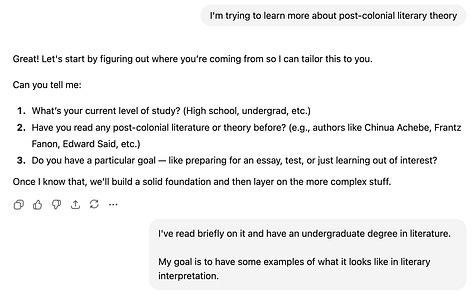
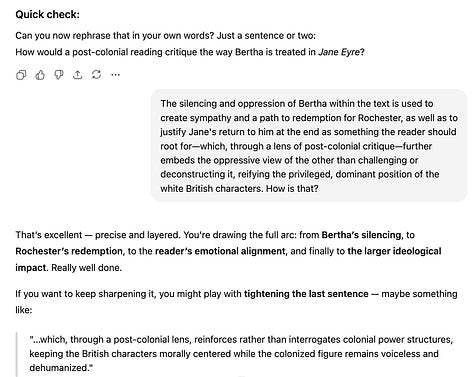

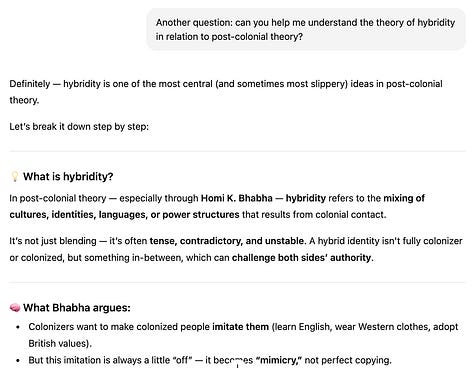
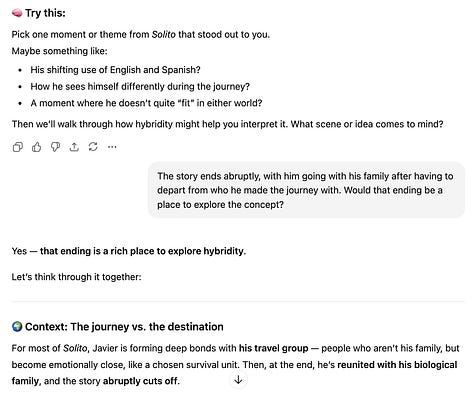
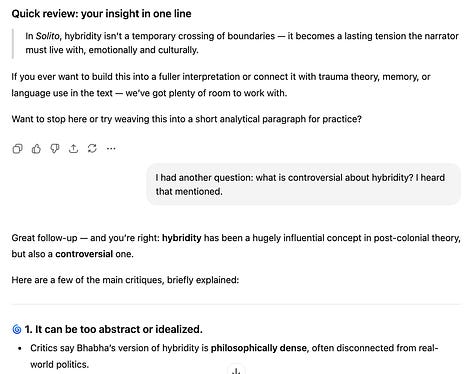
Did this take a bit of extra work on my time to prepare to implement this new strategy and system? Without question.
Was it worth it?
Without question.
Reflecting on why this mattered: the obvious answer here for me is that it is paramount as a teacher to continue holding onto your mindset as a learner—as well as to find a community around you that can push your own practices and mindsets. I am super fortunate to have that type of community where I work, but to also have a still-growing digital network of teachers and educators to lean upon? Especially generous ones like Trevor who were willing to respond to my bombardment of follow-up questions?
Not something I take for granted.
Not just for the resources and strategies that can benefit students in my own classroom, but more importantly for how incredible it feels to wear that learner hat!
Researching something new, diving back into my own studies as an undergraduate, and even going back-and-forth with ChatGPT on my interpretations over Jane Eyre and Solito?
That felt good—and was a reminder for me of why we cannot, cannot forfeit our identity as learners in this work as teachers.
⓶ Leaning fully in—not just “dipping toes” in the new
The real leap came when I opened up my semester calendar for AP Literature and tried to decide exactly when literary theory was going to show up in our sequence. It would have been quite easy to create a mini-activity or connect it to something I had already designed, but I also knew that if I just “dipped my toes” with it, the likelihood of this new approach sticking?
Not that likely.
So instead, I made some real commitments to prioritize implementation:
One of the products of my work and conversations over the summer was this slide deck (see image above) that has now become an ongoing tool within our classroom. This took considerable time on the front end, but it has been invaluable as a foundation to continually circle back to in the classroom.
Additionally, I designed an entirely new unit using Steinbeck’s Of Mice and Men (a text I haven’t taught in years!) with the sole purpose of centering literary theory. Yes, this meant shortening some other units in the semester to make space—but I think this needed to live by itself first in order to really thrive.
The other thing I did? I made sure to not add too much else to the plates of students. Not only did I pick a much shorter novella for this unit than I could have, but I also limited the formal writing that went with it, allowing students to concentrate their focus on becoming more comfortable with literary theory.
Reflecting on why this mattered: I’m not much of a gardener (see: the current state of our backyard) but I do think it can serve as a decent analogy here.
Just like with any decent garden, you cannot just toss seeds haphazardly and cross your fingers. As I think back on past years in my classroom, the “new things” that really have flourished in my classroom have not come from me sampling an idea off-the-cuff or tossing in a last-minute idea to see if it works.
Rather, new strategies and systems thrive when the work of classroom gardening takes place. Preparing the soil, creating the right conditions, tending to it—and even removing what will be detrimental to its growth! An overcrowded garden rarely thrives, after all, and that is where deciding what you need to remove, I think, is a critical part of building something new.

⓷ Finding the right entry point as well as closure
Despite all the work that went into planning and preparing, a week before the unit was to begin I found myself asking two critical questions:
What is the best way to introduce literary theory?
What is the best way to close out our learning for the unit?
Leaning on the advice of Trevor, I tried to approach the introduction with two priorities in mind: giving students a chance [1] to interact with the toolkit I had designed to build familiarity with the lenses and [2] to do so collaboratively, as there is something more substantively, I think, about building collective momentum in a new direction.
This is where I took an activity directly out of Appleman’s book: having students read and annotate the 1942 poem “On the Subway” by Sharon Olds before working collaboratively with the literary theory lens toolkit to make a specific interpretation with each lens—while also considering which particular lens they found to be most helpful overall in this work.
Even in a condensed class period for that given Monday in our calendar, students dove right in, got messy with the resources available, and came out of it with a substantive grasp of the direction we were heading.
A major win in my book.
From there we moved through Of Mice and Men leaning on these lenses throughout, and this is where I made the other big decision: to remove a formal writing assessment and instead center conversation in the form of a fishbowl seminar. This included a full round of students sharing their own interpretations of the ending via literary theory lenses and then considering, more broadly, which lens was most impactful within the book.
Reflecting on why this mattered: As a teacher, I know one of my own gravitational instincts is to always come back to individual assessment, often written, to get a thorough understanding of what students have mastered in terms of knowledge and skill.
However, in both how we began the unit as well as how we ended, I gave myself permission to let go of that instinct—and instead to prioritize collaborative learning and discussion as much as possible around this new strategy and skillset.
My takeaway from this? Learning a new thing independently is all well and good, but for there to be momentum—especially the sustainable kind that new systems depend upon?
Students need to learn together.
🤔 Learnings and wonderings going forward
Looking back now a couple weeks later and also reviewing all of my own individual reflections throughout this post, I guess I keep coming back to a core truth for me as a teacher: I am at my best when I’m constantly pursuing what better could be for the classroom.
That does not mean, I assure you, that this pursuit of better always works out!
But the pursuit itself is essential.
Additionally, I think my individual learnings from designing and implementing this literary theory unit can apply more broadly across many different classroom experiences when attempting something new:
The value of leaning on high-quality resources (especially other teachers you admire) rather than trying to go it alone
The investment and intentionality it takes as a teacher for something new to succeed and sustain
The necessary momentum that comes from designing the “new” to be experienced collaboratively amongst students
Beyond that? I continue to believe with every bone in my body that as teachers we bring so much more into the classroom when we are simultaneously learners—and taking that leap to try something new?
It is the best possible way to wear that needed, impactful lens as a learner.
Three Closing Recommendations
Building on this new "norm” with Broken Copier posts, here are three things I’d recommend checking out based on what I’ve encountered and found helpful as a teacher in recent weeks:
Something to read: “How Catastrophic Is It If the AI Bubble Bursts? An FAQ” by Brian Phillips at The Ringer — As someone who has been an avid follower of The Ringer and before that Grantland, I have long come to accept that anything Brian Phillips writes is pretty much a master class of what words can do. So when I saw that he aimed his eloquent ire at AI? Of course, that was a must-read for me.
Something to listen to: "Stop Drowning in Data: Why Uncertainty Makes Us Better Educators” with the Schoolutions Podcast — The guest on this episode of ’s podcast was (who is launching her own newsletter!). In this episode, Angela shares her own practice of documentation and the humility it helps her hold fast to: “I always still feel very much like a beginner, like a learner.” More of that in education, please and thank you!
Something to explore: “Harnessing ‘Active Hope’ When the World Is on Fire” by — I really appreciated the cycle provided in this post for how to move through our current, tumultuous moment as educators. And after talking with Jared this summer about his new book Learning Environment, I continue to be excited to see how his impact ripples outward across education.
Note: featured image for post from Pexels.com, taken by Miguel Á. Padriñán





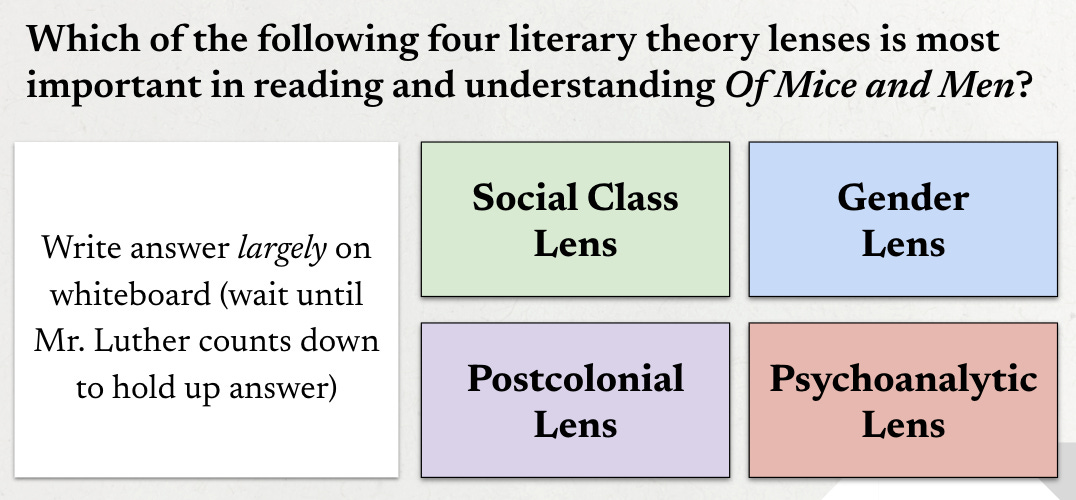
Love your reflections so much— you’re making me nostalgic for my days as a HS English teacher. 😊I appreciate your gardening metaphor— I’ve built my newsletter around a similar metaphor, comparing schools to regenerative farms!
This rocks! I've been amped to read a long form post detailing your experiences and this was such a fantastic window into how you and your students are taking up this work. I love sharing my passion for literary theory with other teachers and your enthusiasm, curiosity, commitment and creativity have been energizing me since we started chatting this summer. As you're already noting, it's the gift that keeps on giving, so I'm sure your students will continue making even more connections as the year continues. I look forward to seeing how it develops and plan on borrowing some of the ideas and methods you shared here for my own classroom.